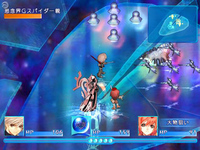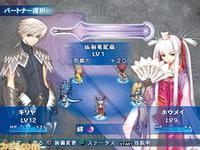|
|

|
PLATFORM
|
PS2
|
BATTLE SYSTEM
|

|
INTERACTION
|

|
ORIGINALITY
|

|
STORY
|

|
MUSIC & SOUND
|

|
VISUALS
|

|
CHALLENGE
|
Easy
|
COMPLETION TIME
|
20-40 Hours
|
|
OVERALL

|
+ Mission variety
+ Partner mechanic used well
+ Handy combat structure
- Lackluster AI
- No dashing in battle
- Sega didn't localize it
|
Click here for scoring definitions
|
|
|
As Shining Force EXA was to Shining Force Neo, so Shining Wind is to Shining Tears: a refinement of the earlier game's mechanics that improves them. Shining Wind actually managed to do what no other action-RPG Shining title achieved before though — make me like it. This is a game that does a lot of interesting things and executes them well enough to stay engaging throughout. Naturally Sega demurred on bringing it across the Pacific when every prior action-RPG Shining game made the trip, ensuring that interested parties have to wade through the Japanese version now, but the effort is actually worthwhile.
Shining Wind looks very much like its predecessor at first glance, even recycling a few of Shining Tears' enemy sprites. A variety of missions demand that the player go on an action-RPG killing spree, smacking enemies and occasionally collecting loot from their corpses. A pleasant aspect to the missions is that they rarely require everything to be killed, though doing so would usually be helpful. A few of them require defense of some target, some merely require a certain number of enemy leaders to be slain, and others feature enemy targets that must be destroyed. This variety is a strong point, allowing the game to progress without feeling overly repetitive. Even though the same battlegrounds are reused later in the game, the goals and opposition change for each fight, which helps keep things fresh. Deciphering exactly what is required can be difficult if one does not understand Japanese, but losing a battle simply tosses the player back to headquarters free to immediately try it again with no repercussion, so divining the intent through practice becomes possible. With the exception of a few bosses, notably the last one, the game's difficulty is not overwhelming, so losing by being taken down is not a frequent occurrence.
A key mechanic of Shining Tears was always saddling the player with a partner, something that Wind continues to promote. Where Shining Wind improves on the idea is in making the second character much more helpful. The protagonist actually wields a somewhat different weapon depending upon the partner with him, which alters the moves he can use in a battle. By pressing R1 the other character is locked in place and link abilities become usable, which produce different results depending on how far the protagonist is from his partner. These are quite helpful, as simply mashing the square button over and over is not the smartest way to go about eliminating the opposition. Depending upon the AI to do a good job is still unwise, and the player will often need to use the right analog stick to move an inconveniently stupefied partner, but they do a very good job of justifying their presence on the battlefield.
Though it is in Japanese, simply playing Shining Wind is not a difficult endeavor. Most of the time a key location the player needs to visit will be highlighted with an exclamation point on the world map, and any time a certain character needs to come along he or she will also be clearly marked upon departure. Once battle has been joined the player is returned to headquarters between each phase of combat, which allows one to save or deal with inventory issues during the many campaigns with multiple segments. Starting the battles is as easy as walking into a key room at headquarters, and this allows importers to muddle through most of the game easily.
 Get that spider to win the day, or get whipped and booted out of the dimension. Repeat!
Get that spider to win the day, or get whipped and booted out of the dimension. Repeat!
|
|
Something of a hindrance is how slowly most of the characters move in battle. They move almost as if underwater, though since the enemies aren't much faster it's not an insurmountable problem. The presence of a dash button when moving around non-combat environments makes the slow movement in a fight more aggravating, along with the presence of one character who zips along at double the speed of others.
Shining Wind uses a unique mechanic for enemy encounters while wandering between places on the world map. Dangerous areas have things called Chaos Gates floating around, and upon contact with them the player is thrust into a small ethereal area with a boss opponent, its grunts, and a statue. Killing the boss wins the day, while if the statue is broken or the protagonist gets taken out the player loses. A loss simply means being tossed back into the surrounding environment though, and avoiding the Chaos Gates is not difficult to do if one is in a hurry.
Inventory management is not a joy in Wind, but neither is it the infuriating experience of Shining Tears. The lack of any option to sell or appraise multiple items simultaneously is a bother when scores of things are in need of it. On the other hand, switching between the many characters to compare new equipment effects is quick and easy, while the proliferation of items which required character statistics to be at a certain level in Shining Tears has been massively shrunk. The atrocious load times found in Sega's localization of Tears will not be found in Wind, letting screens change at a good pace.
Importers will face something of a chore in making sense of the story, but what can be deciphered is rather interesting after a long-winded introduction. The protagonist, Kiriya, and his school friend Sheena are suddenly transported from their unremarkable Japanese locale to the world in which Shining Tears took place. There they suddenly display considerable aptitude at combat, and Kiriya demonstrates the ability to pull magical swords out of the chests of partners to enhance both their combat faculties. Kiriya gathers a large number of allies as the story progresses, including another school chum, and he needs the help to slaughter the encroaching imperial forces seeking to conquer the continent. Even through the language barrier most of the characters are appealing, though as a teenage protagonist Kiriya sounds some notes that will be overly familiar to anyone with some RPG experience.
 Houmei is supposedly 3000 years old. Obviously her beautician could patent his process.
Houmei is supposedly 3000 years old. Obviously her beautician could patent his process.
|
|
One aspect of Shining Wind does present something of an obstacle to importers, which is the means by which Kiriya strengthens his relationship with partners. The actual mechanics of it are simple enough, as a series of soul crystals are obtained while exploring the game's environments and through conversation with the characters who will be affected. These crystals are then used to unlock doors within the souls of the partners, and doing this strengthens the power of the sword Kiriya uses with each one. The problem is that an unlocked soul door produces a large text dump with a few images straight out of a visual novel depicting interaction with the character's inner self, which will be a test of patience for those unable to understand what is being said on the screen. Skipping quickly through it is always an option at least, and the favorable results of this procedure make trying it a few times useful.
The visuals of Shining Wind are extremely similar to those in Shining Tears, which had nice but not revelatory sprite work. The character illustrations that accompany story sequences make clear the gulf between the sprites and their inspiration, though at least the environments are well varied and colorful. The synth score accompanying the action is some very catchy work, and many compositions are capable of staying with the player for a long time. As for the voice acting, all the performers fit into their roles well. Some are better at expressing a variety of emotions than others, but Japanese voice actors rarely turn in substandard jobs.
It's finally happened: I played a Shining game from Sega's revival of the franchise that I actually like. Shining Wind represents a massive improvement over what came before, so of course Sega stopped localizing these games in order to prevent it being experienced by most outside of Japan. That shouldn't stop anyone interested in an inventive title that can be tackled with minimal Japanese knowledge from seeking a way to try it. This was a pleasant surprise for me to experience and hopefully others will find it that way too.
Review Archives
|









